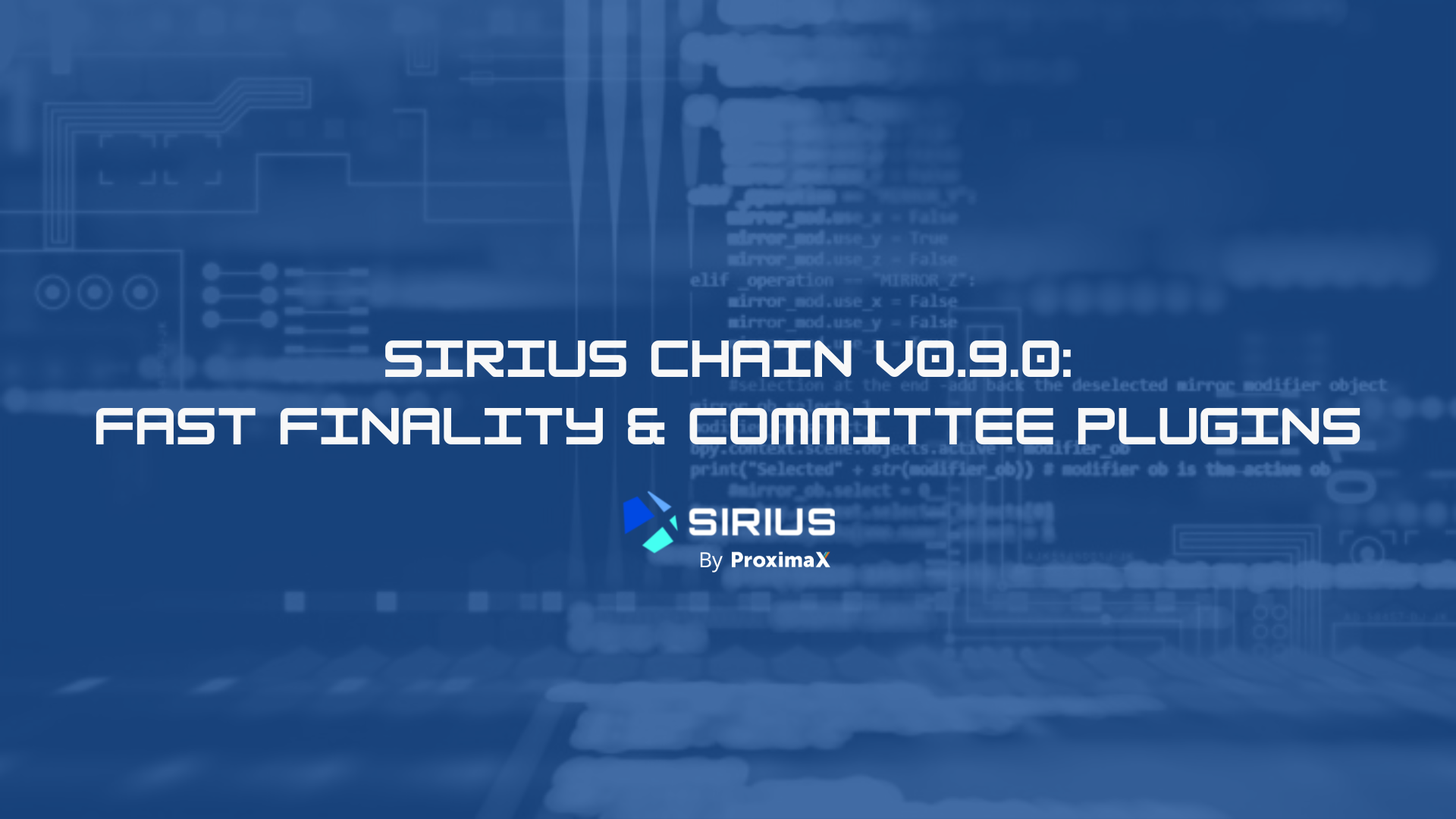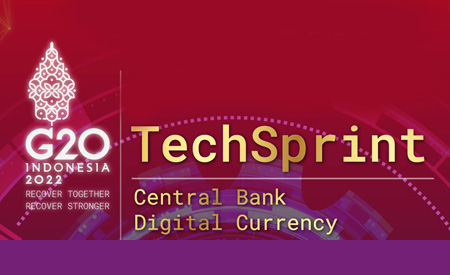Research Papers
Latest News

DRAGONFLY FINTECH WINS G20 TECHSPRINT 2022 GLOBAL CBDC CHALLENGE
JAKARTA, INDONESIA / 12 October 2022 – We are delighted to announce that Dragonfly Fintech Pte. Ltd. has won the much coveted G20 TechSprint 2022 challenge...

Sirius Chain v0.9.0: Fast Finality and Committee plugins
We are pleased to announce that after months of toiling and testing, our core developers have successfully upgraded Sirius Chain to v0.9.0...

Dragonfly Fintech named Finalist of G20 TechSprint CBDC challenge by BIS Innovation Hub and Bank Indonesia
BIS Innovation Hub and Bank Indonesia have officially announced the finalists for this year’s G20 TechSprint CBDC challenge and we are delighted that Dragonfly Fintech, an innovative fintech solution provider utilizing ProximaX’s blockchain protocol, has been shortlisted as one of the finalists...
Frequently Asked Questions
Platform
What is ProximaX?
ProximaX is a project dedicated to building and promoting ProximaX Sirius, a powerful developer-friendly and enterprise-ready infrastructure platform and development framework powered by blockchain technology.
How does ProximaX work?
The ProximaX Sirius platform consists of multiple servers distributed in a network. It follows a "hub and spoke" design where the core component is the blockchain, or the "hub," and the other components are service layers, or "spokes". The service layers consist of P2P and distributed storage, streaming, database, and Supercontract where:
- - All storage, messaging, and transactions are encrypted
- - Streaming includes text, video, and voice data
- - All events are time-stamped in the blockchain
- - Automated business and process executions are conducted through off-chain Supercontract
Additional service layers can be added to ProximaX Sirius to offer more functionalities. These layers may be anything from specialized services such as artificial intelligence to distributed computing for genome sequencing.
With the expansion of service layers, however, the performance of individual layers remain unaffected. This is similar to ten sets of network server nodes running in parallel and held together by the blockchain at the core. Each set of network nodes performs a specific function, and the function power grows with more server nodes plugged in.
How can ProximaX be used?
ProximaX uses are many, but not limited to, content delivery and storage such as file hosting and sharing services, supply chain management, content creation and the monetisation of such contents, content control, multimedia & message streaming, decentralized marketplaces, Big Data, measurement/analytics, IoT, flawless record keeping and Know Your Counterparty (KYC).
What is ProximaX’s vision?
Our vision is to make blockchain relevant by integrating distributed technologies such as streaming and file management systems, thereby providing a practical holistic platform that is suitable for applications and industries at large.
Is ProximaX just another blockchain?
No, ProximaX is a holistic development and infrastructure platform powered by blockchain technology.
Is ProximaX decentralized?
Yes.
Since when has the network been up and running?
Sirius Chain mainnet was launched on 25th September 2019. This was followed by the launch of Sirius Storage and Supercontract mainnets on 22nd November 2020. More recently, we launched our Stream testnet on 2nd January 2021 and we are working towards launching the mainnet for this layer later this year.
Is ProximaX competitive to Ethereum (and all its forks)?
ProximaX is not a blockchain per se but rather a platform solution and framework for content, storage, database, streaming and messaging. Ethereum and other blockchain projects have a different application scope that is only pertinent to blockchain technology. ProximaX is a holistic enabler that can power solutions for almost all industry verticals by providing complete and enhanced blockchain driven solutions.
Layer: Application (API gateway)
Will there be an API?
Yes, ProximaX will be API driven so developers can use the platform easily. In addition, there will be SDKs that will be available for developers to easily use the platform. Each layer of the platform solution will be available through the SDK.
Will all API calls of Catapult be available through the ProximaX application layer?
Yes, through our Sirius platform SDK.
Layer: Storage
What is the storage layer?
It is a Distributed File Management System (DFMS) that is presented as another component on our platform.
What is the cost of the file storage compared with the traditional one?
It is expected that cost will be lower than traditional solutions such as cloud services because the utilization of hard disk space will be maximized with our platform solution.
Will ProximaX fork IPFS or will it use existing global IPFS network?
We will not use the existing global IPFS because it is required as a component of our platform. In addition, it is a forked component of the IPFS.
How will this affect copyrighted material posted on ProximaX, especially regarding DMCA takedown notices?
ProximaX is trying to design a “denylist” for the storage solution and the idea is to block certain data hash that will be sourced or coming from the likes of DMCA takedown notices. We are still in the middle of our research and design. It’s a concern that we would like to address but at this moment we don’t have a solution because this is a decentralized public network.
Are the files on ProximaX storage encrypted?
The application built on top of the storage layer will encrypt and decrypt files.
How are files stored?
Files are split into small chunks of binary code known as shards. These shards are linked to each other using a dynamic hash table (DHT). In addition, all are replicated to the other replicators which are part of the contract.
What happens if some nodes are switched off or become inaccessible?
If this happens, other nodes will join the contract and the files affected will be replicated to these nodes.
Is ProximaX competing with SIA and Storj?
ProximaX is a comprehensive development and infrastructure platform which offers Storage as one of its service layers. While this enables developers to build applications to offer services akin to SIA and Storj, the ProximaX platform is far more extensive than this.
Layer: Streaming/Messaging
What could be examples of use cases for ProximaX Stream?
ProximaX Stream layer can be used to develop applications and solutions to stream live or pre-recorded instances such as for news, movies, music, events, podcasts, video conferencing, and messaging.
Is end-to-end encryption included?
Apps will have to encrypt onion layers, but will be covered by the SDK.
Layer: Database
What is the core of the database layer?
The database layer is only available for the private net and it can be any distributed database such as BigChainDB or TiDB.
Layer: Executor/Super Contracts
Is it possible to convert an Ethereum Solidity project to ProximaX easily?
There is probably nothing to convert from, and it is much easier to start afresh on ProximaX.
Is it possible to create a decentralized Exchange on ProximaX?
Yes this can be done but we do not believe that the P2P technology will be able to support high frequency trades.
Layer: Consensus
What are the consensus protocols?
The consensus protocol consists of Proof of Stake (PoS), Proof of Storage (PoSt) and Proof of Bandwidth (PoB). The idea behind PoS is to generate coins from transaction fees without using vast amounts of energy. Please read our whitepaper for more information about this.
Is it possible to create a decentralized Exchange on ProximaX?
Yes this can be done but we do not believe that the P2P technology will be able to support high frequency trades.
What is Proof of Stake (PoS)?
It is used as a method to solve a block depending on their stake in the market, which allows everyone on the network to have the same reward potential. The idea behind PoS is to generate coins from transaction fees without using vast amounts of energy.
What are Proof of Storage (PoSt) and Proof of Bandwidth (PoB)?
Proof of Storage (PoSt) is a method where a single node dedicates a non-trivial amount of disk-space to solve a challenge presented by the service provider. It is very similar to Proof-of-Work (PoW) where instead of computation power, it is storage capacity. PoSt is relevant yet considerably different from memory-hard functions and proofs of retrievability.
Proof-of-Bandwidth (PoB) is a consensus mechanism where multiple oracle verification will be used to report and validate P2P nodes’ bandwidth contribution to the network.
Layer: Tokens (XPX/XAR)
What is ProximaX's native token?
The ProximaX native token is XPX. XPX has no security instrument tied to it and is a consumptive or utility cryptocurrency whose value is determined by market demand and supply.
What is the purpose of the XPX token?
XPX is used as a utility token to subscribe to the services offered by application service providers.
What is the ProximaX Economic Model?
ProximaX tokenomics centres around developing an ecosystem where services on the ProximaX Sirius platform are acquired using XPX.
How many XPX are there?
Total XPX token supply is 9 billion.
What was the ICO price?
Around US$0.0095.
How long will my KYC data be stored?
5 years.
Why is my KYC data stored for multiple years?
Due to anti-money laundering rules, KYC is required to be stored for a set period of time.
Applications (KYC/Vault/etc)
Is there a special client being built for ProximaX (an all-in-one client)?
Building for an all-in-one client per se is not part of ProximaX’s plan but simple services can be incorporated into the wallet. The ProximaX’s platform shall have easy-to-use APIs and SDKs for Apps to be developed upon.
What languages do I need to learn as a developer if I want to use ProximaX?
You only need to download the right SDK (Go, C#, Typescript, etc) to start using the ProximaX platform. One of the main goals of ProximaX is to create an easy-to-use platform for developers.
We’re Stronger Together. Contact Us Today
To find out more about how our solutions can make your business more lucrative, or to become a ProximaX technology partner or systems integrator, drop us an email.
Contact Us